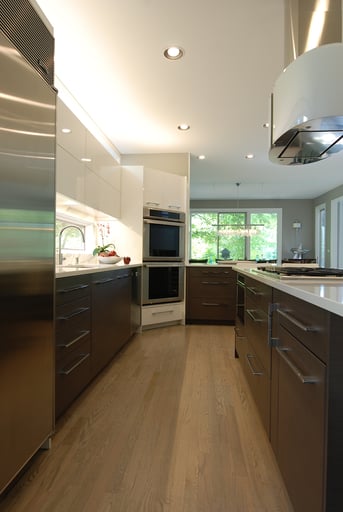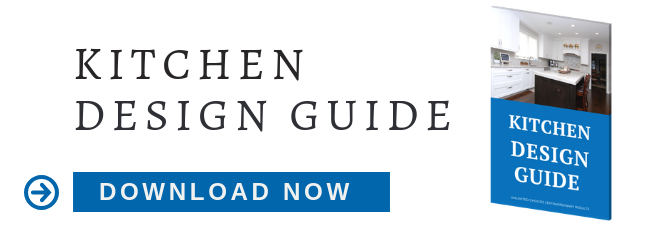 Stoves, cooktops, ranges – aka those things you use to cook food on top of your countertop instead of an oven – are kitchen essentials. Equally essential is knowing that you’ve chosen the best stove for your kitchen, that it’s placed for maximum kitchen efficiency, and that it’s vented properly to get smoke, grease, and odors out and away from your living spaces.
Stoves, cooktops, ranges – aka those things you use to cook food on top of your countertop instead of an oven – are kitchen essentials. Equally essential is knowing that you’ve chosen the best stove for your kitchen, that it’s placed for maximum kitchen efficiency, and that it’s vented properly to get smoke, grease, and odors out and away from your living spaces.
Over the years, we’ve helped thousands of homeowners do all of the above for their Chicago kitchen remodels. By distilling their cumulative needs, questions, and concerns, we’ve consolidated them into the four basic things worth understanding about stoves.
1. How to Choose the Right Stove or Range
Before we start, are you unclear about the difference between a stovetop and range? You’re not alone. Click Here to learn more about the difference between the two.
To choose the right stove or range, evaluate three key considerations:
· Your budget. While expensive, fancy ranges are nice, there are plenty of high-quality, perfectly functional stovetops available. Be honest and clear with your kitchen budget, so you’re making selections from appliance and feature options respectful of your bottom line.
· Utilities. Pay attention to utility bills. If you have solar panels or your electricity is consistently more affordable than gas, an electric or induction cooktop may make the most sense. If gas is cheaper, or you just can’t stand to cook without an instantly controllable flame, then don’t bother looking at trendy, electric options you wouldn’t be happy with in the end.
· Location. Some cooktops or ranges might make more sense than others based on where they’ll be located. Your kitchen designer is your greatest ally in considering the layout, location, and function – balancing your top choices with fluid, kitchen workflow.
Then, there is the consideration of “How” your household uses the kitchen and the types of foods and meals you prepare there. For example, if you cook far more than you back, your cooktop might be far more of a priority than if you’re a serial baker and oven roaster, who only occasionally requires intricate function from the stovetop.
2. What’s the best option if we don’t have gas?
First off, if your current kitchen was built with electric ovens and stovetops, and you prefer gas, your Chicago kitchen remodeling project offers the ideal time to make that happen. If budgeting constraints make that addition prohibitive, or you don’t care enough about gas to go through the hassle, you’ll be choosing between an electric or an induction cooktop. Both are popular options, particularly for those who prefer more modern or contemporary kitchen designs with clean lines and sleek surfaces.
Electric cooktops
Electric cooktops have heating elements installed below smooth, durable glass or ceramic surfaces. While that technology has come a long way, they still require a bit of extra care and maintenance to prevent cracking or breaking – and to ensure the surface remains as appealingly scratch- and divet-free as possible.
Glass or ceramic cooktops aren’t always the best option for families with small children who like to help with cooking. Also worth noting is that, while the elements glow red as long as they’re still warm (even after they’re turned off), younger children or seniors who can’t see as well are more susceptible to burns.
Induction cooktops
The newest kid on the stovetop market, induction cooktops have taken the kitchen design world by storm. They are very energy-efficient because no pan means no heat – so they’re only operating when you want them to. Rather than heat transferring from coils to the surface of the glass - and then into the pan (as with electric stovetops) - induction technology uses magnets to transfer heat from the magnetic coil to the pan bottom and its contents. The surface of the stove remains cool to the touch unless a pan is sitting on top of it – even if an element is left on high.
One of the biggest “cons” of induction cooktops is that they only work with certain types of pots and pans, which might mean replacing your current pots and pan favorites.
Visit our post Cooktop Options for Your Kitchen Remodel: Induction vs. Electric for more information on both options.
3. What’s the best location for the stove (perimeter countertop or the island?)
It’s very rare these days that we design a kitchen without a kitchen island. And, while some homeowners opt for a freestanding island model, most build permanent islands and then decide what to do with it.
This means you have the option of installing your stove in the perimeter countertops, or you can install it on the kitchen island. In either case, you’ll want to establish which location makes sense for the hub of the kitchen work triangle, and then base your decisions from there.
If your future kitchen island is a top contender, read The Pros & Cons of Designing a Kitchen With a Stove or Cooktop in the Island. If the island is your top choice, pay even closer attention to the next item of business, which is all about the hood and ventilation options.
4. You’re going to need a hood (or some type of ventilation)
That brings us to the fourth thing to understand about stoves. The steam, smoke, and odors produced by their use require ventilation of some sort. Currently, the building codes do not require the installation of a range hood (IRC M1503.1) as long as another form of mechanical or natural ventilation is provided. That said, an open window isn’t enough to truly vent cooking vapors, grease, and odors properly, so most homeowners select a hood or vent of some type.
Some hoods filter the vapor and cooking byproducts and expel it right back into the home, others are ducted to vent outside. Some are attached to a microwave (called a microhood) installed above the stovetop, others are integrated more into the cabinetry or even custom-designed to be decorative as well as functional kitchen features. There are also stylish hoods designed specifically for those who install their cooktops on the island.
Our post What Range Hood is Right for You and Your Chicago Kitchen Remodel is a good place to start researching your options, but nothing compares with a face-to-face consultation with a high-end kitchen designer.
Ready to take what you’ve learned about stoves and discuss your options with one of Chicagoland’s premier kitchen design and build teams? Schedule a consultation with Kitchens & Baths Unlimited.



